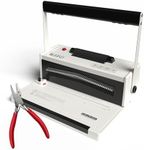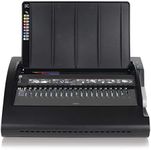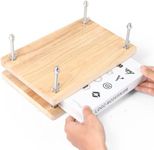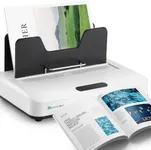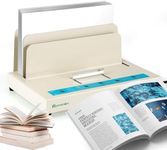Buying Guide for the Best Coil Binding Machines
Choosing the right coil-binding machine can make a significant difference in the efficiency and quality of your document binding tasks. Whether you need it for personal use, a small office, or a large organization, understanding the key specifications will help you make an informed decision. Here are the main factors to consider when selecting a coil-binding machine.Punching CapacityPunching capacity refers to the number of sheets a machine can punch at one time. This is important because it affects how quickly you can prepare your documents for binding. Machines with a lower punching capacity (up to 10 sheets) are suitable for occasional use or small projects. Medium capacity machines (10-20 sheets) are ideal for small to medium-sized offices. High capacity machines (20+ sheets) are best for large volumes of work. Consider how often and how many documents you need to bind to choose the right punching capacity for your needs.
Binding CapacityBinding capacity indicates the maximum number of sheets that can be bound together in a single document. This is crucial for ensuring that your machine can handle the size of documents you typically work with. Machines with a binding capacity of up to 100 sheets are suitable for small reports or booklets. Those with a capacity of 100-300 sheets are good for medium-sized documents, while machines that can bind over 300 sheets are necessary for large manuals or thick books. Assess the typical size of your documents to determine the appropriate binding capacity.
Electric vs. Manual OperationCoil-binding machines can be either electric or manual. Manual machines require you to punch holes and insert coils by hand, which is suitable for low-volume tasks and occasional use. Electric machines automate these processes, making them faster and less labor-intensive, which is ideal for frequent or high-volume binding. If you bind documents regularly or in large quantities, an electric machine will save you time and effort. For infrequent or small-scale use, a manual machine may be sufficient and more cost-effective.
Coil InsertionCoil insertion can be done manually or automatically. Manual insertion requires you to thread the coil through the punched holes by hand, which can be time-consuming for larger documents. Automatic coil inserters streamline this process, making it quicker and easier. If you frequently bind large documents or need to save time, an automatic coil inserter is beneficial. For occasional or small-scale binding, manual insertion may be adequate.
Durability and Build QualityThe durability and build quality of a coil-binding machine determine its longevity and reliability. Machines made from high-quality materials and with robust construction are more likely to withstand frequent use and last longer. Consider the environment in which the machine will be used; for heavy-duty, frequent use, invest in a machine known for its durability. For occasional use, a less robust machine may suffice. Always check user reviews and manufacturer specifications to gauge the build quality.
Ease of UseEase of use encompasses how user-friendly the machine is, including features like adjustable settings, clear instructions, and ergonomic design. A machine that is easy to operate will save you time and reduce the likelihood of errors. Look for features such as adjustable margin depth, easy-to-read guides, and comfortable handles or buttons. If multiple people will be using the machine, or if you are new to coil binding, prioritize a model known for its simplicity and ease of use.
